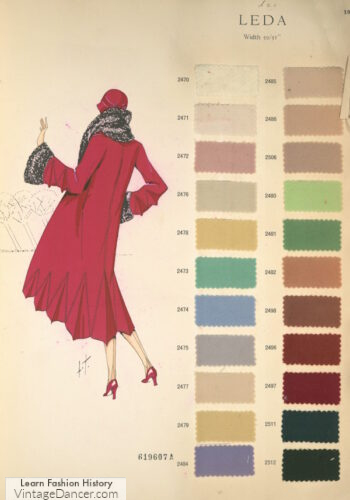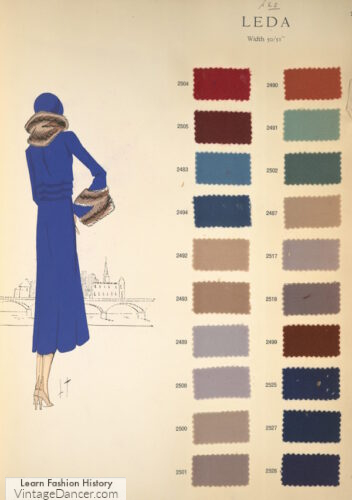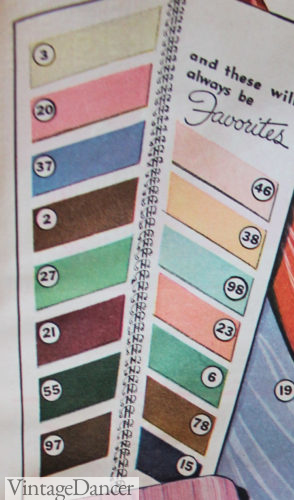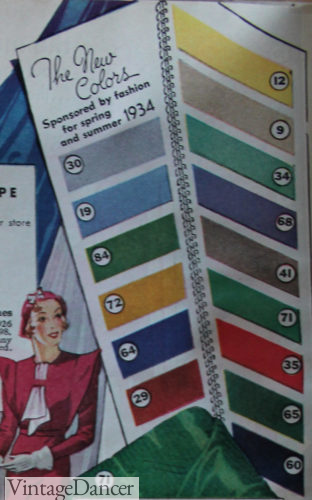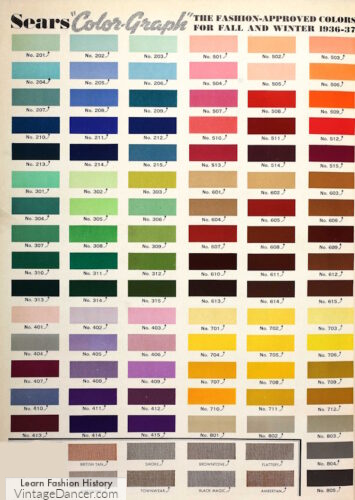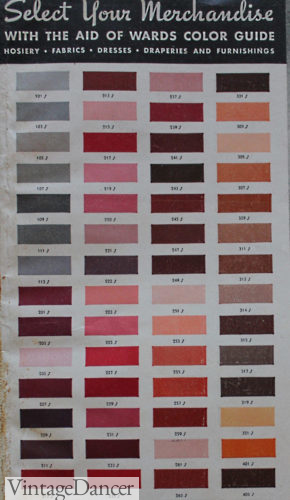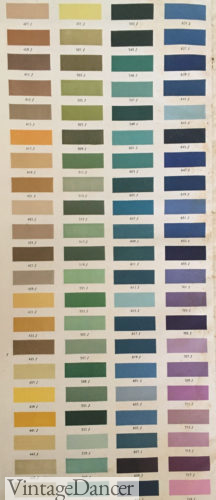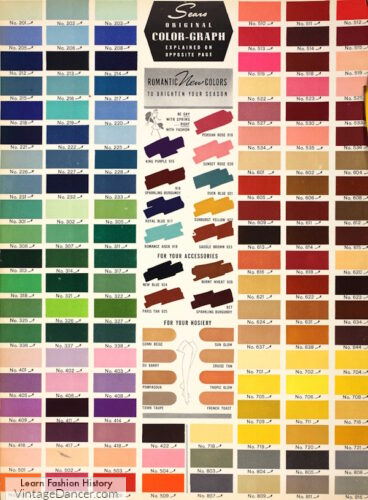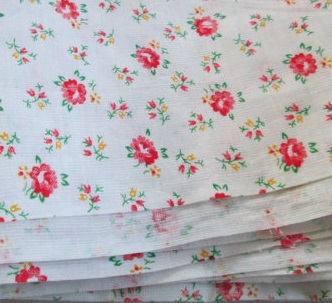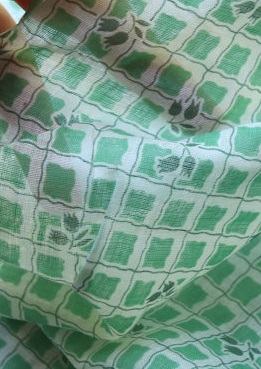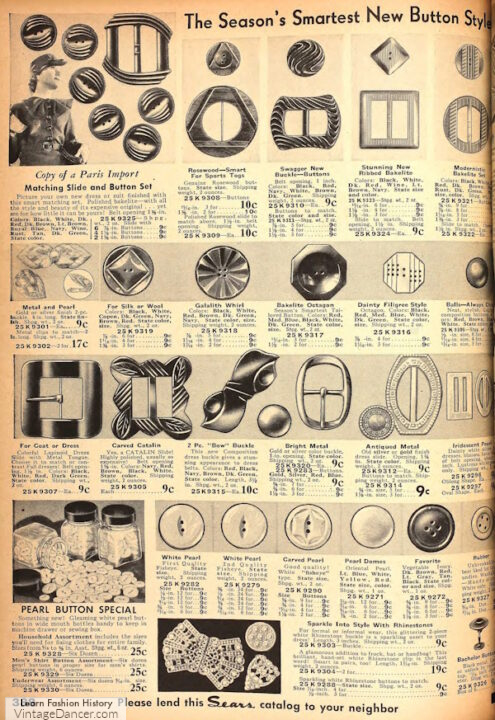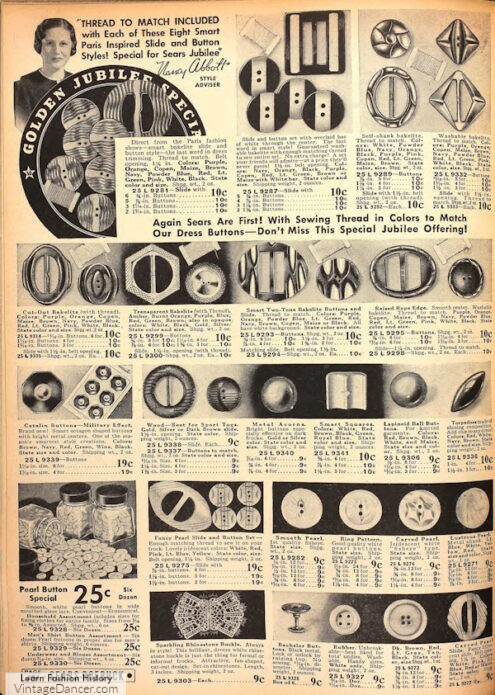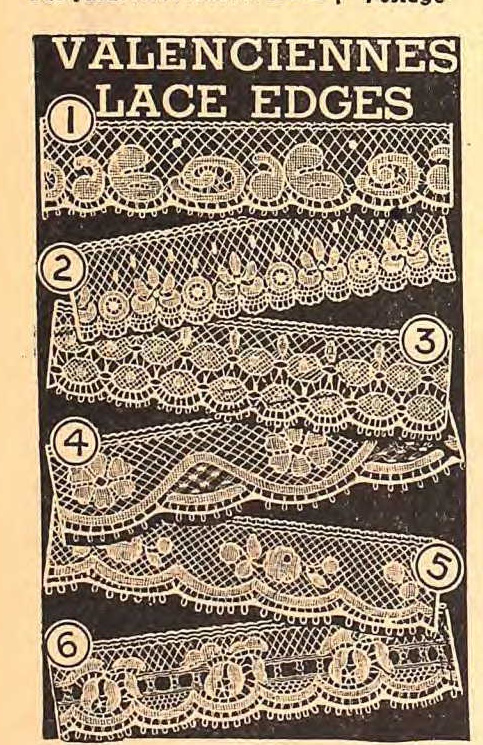What colors did people wear in the 1930s? Knowing what fashion colors were common in the 1930s will help you create an authentic 1930s outfit. For women in the 1930s, fashion colors ranged from light pastels in spring to jewel tones and earth tones in fall. The most popular colors in all of the 1930s was white. White dresses, white shoes, and white accessories were worn most of the year.
Besides knowing what colors women wore in the 1930s, an understanding of clothing fabrics is also useful. The first step to sewing your own 1930s clothes is to pick out a sewing pattern, and then the fun part really begins choosing the 1930s fashion fabric!
The following is a guide to popular 1930s fashion colors, fabrics and prints that should help you locate a good thirties fashion fabric to begin your project. While the focus of this article is on women’s clothing you will find 1930s men’s clothing colors used most of the same colors.
1930s Fashion Colors
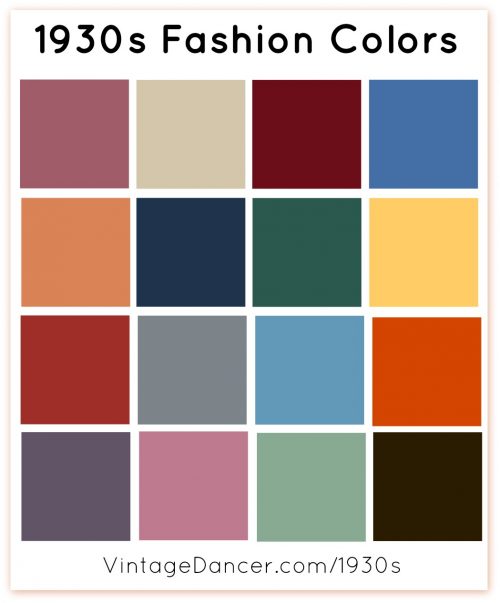
1930s Fashion Colors for All Seasons
There was little change in fashion colors during the 1930s. In spring and summer, women gravitated towards saturated pastel colors such as peach, rose pink, lilac, sunny yellow, sky blue, and sea green. Add to that year round colors of red, copen blue, emerald green, orange, and mustard.
For 1930s winter fashion colors, chocolate brown, grey, tan, rust, burgundy, navy blue, and black were warm and rich.
Notice how the 1930s clothing colors darkened over the decade. Lighter color combinations were worn in the early to mid 1930s while the late 1930s used the same colors but added a heavier saturation to make them bold and confident.
- 1931 French fashion colors
- 1931 French fashion colors
- 1934 pastels
- 1934 rich colors
- 1936 Sears colors- Fall/winter
- 1937 reds, pinks, grey, peach
- 1937 browns, greens, blues, purples
- 1939 Sears colors
1930s fashion color combinations were often contrasting but rarely as clashing as the 1920s. Blue and pink, yellow and green, and tonal variations such as red and pink or brown and tan.
There was one color, however, which was combined with all other colors: white.
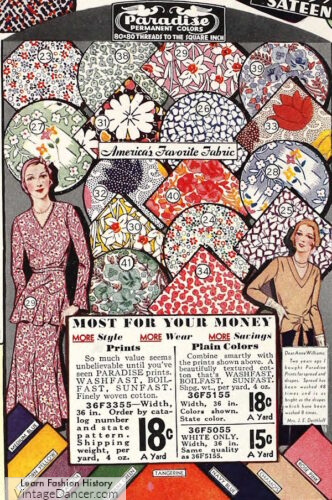
1931 spring florals with white ground
White was the ground or base for many pattern fabrics, from gingham checks to stripes and floral. Red flowers outlined in white, blue dots on white, white embroidery on a solid net. This wasn’t something I noticed until I began to look through the many examples of fabrics sold in the 1930s.
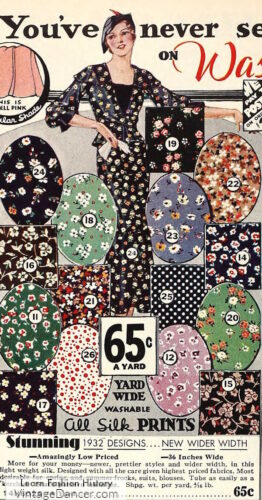
1932 color grounds with white florals
White was everywhere. Perhaps is was an economical way to save on dyeing white fabric. Or perhaps white gave hope during difficult times.
In winter the white did not hibernate. Instead 30s fall and winter fabrics had a color base with white accented prints. Blue, black, red and green were designed with some white florals, polka dots, and small figures.
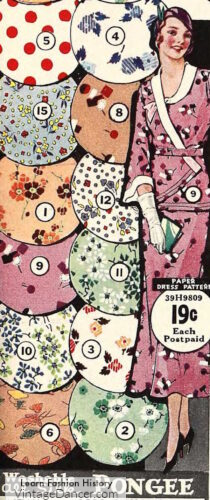
1932 spring prints wore with white, collar, belt and gloves.
If a solid color was worn, you bet white accessories of gloves, belt, purse, and hat were worn, too. White collars on dresses and blouses and white trim around cuffs and necklines were also added to most house dresses and many afternoon dresses. In fall and winter the white accessories were toned down with other colors to coordinate to contrast with the outfit.
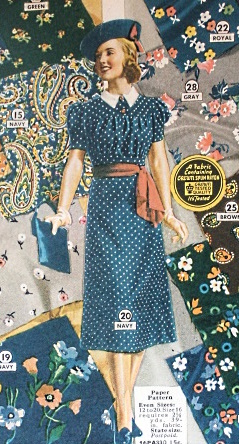
Fall outfit with white collar, white polka dots, and white gloves but accented with a red sash belt.
1930s Fashion Fabrics
With the stock market crash in 1929 limiting budgets, modesty coming back in style, and home sewing being the most affordable way to acquire new fashions, 1930s women turned to the department store or mail order catalog to purchase fabrics. The cost of materials was usually much lower than the cost of ready made clothing.
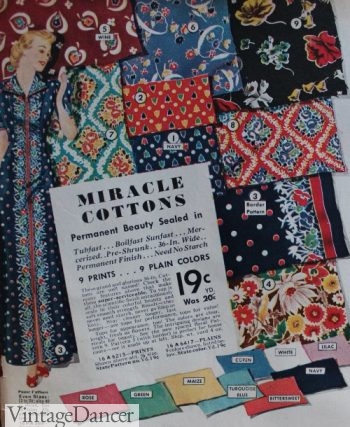
1938 Floral Prints and more
How much did fabric cost in the 19230s? For example, a basic cotton print was 25 cents per yard in 1934, which is about $4.48 USD today. Assuming 3 yards of fabric was needed, the total cost for the dress fabric was about $15.
A new, ready made, simple house dress cost $1.29 or about $23 today. The savings was not great, but combined with upcyling old dresses and reusing old trim, a new homemade dress could and did mean substantial savings.
See typical capsule wardrobes and clothing budgets for women and men in the 1930s.
1930s Summer Fabrics: Light and breathable
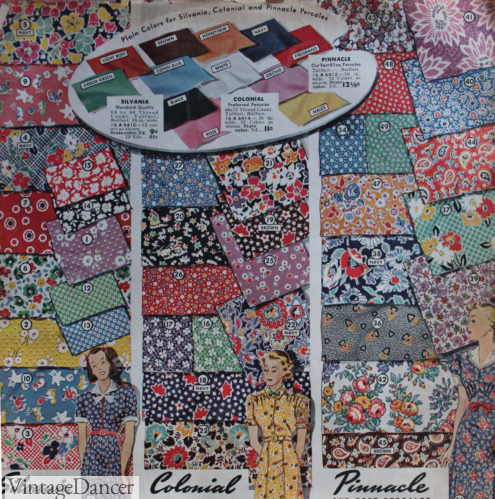
Silvania, Colonial and Pinnacle named print fabrics
Cotton: Cotton came in an assortment of different weights. As a natural fiber, it took dye and printing well, was washable, durable, and breathable in hot weather. It was also prone to shrinking and fading in the sun. Types of 1930s cotton available were broadcloth, cotton suiting, foulard, covert, percale, lawn, batiste, and pique.
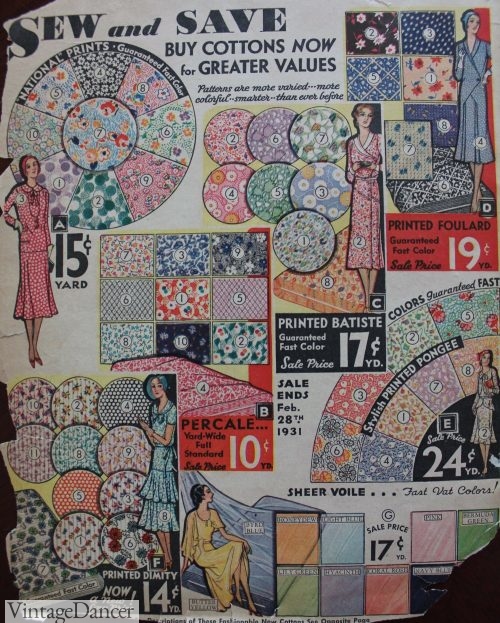
1930 Cotton Fabrics
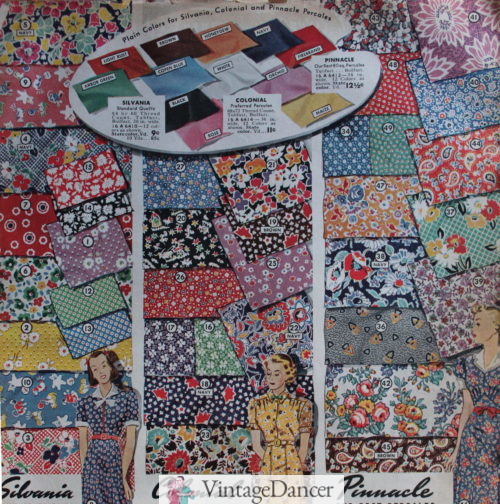
1937 cotton prints
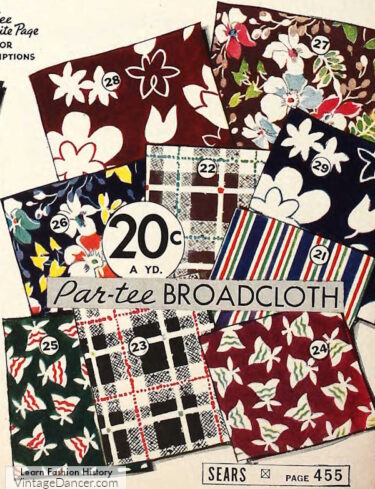
1937 cotton broadcloth
Most fabrics for summer and winter were light and airy. They were each woven into fabrics that were quite often sheer enough to require a full slip or a lining to be used.
Cotton voile was one of the cheapest of the nice options, costing about $2.88 today. Rayon was a little pricier at $7.80 a yard. Silk was about $15 a yard. Crepe, the favorite fabric of the decade, ranged from $10-20 a yard.
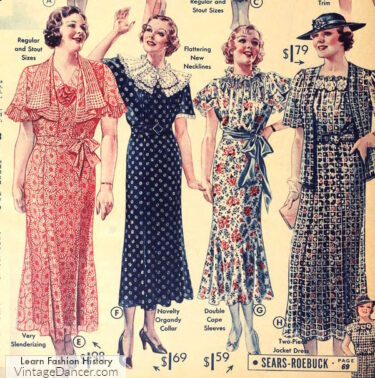
1936 Voile sheer fabric dresses
Dimity: A semi-sheer, lightweight cotton made into dresses and bed linens. It had a slight texture of rows (called corded below). It took a nice, fine print well, especially on a white background. It was prone to wrinkling, but that gave it some personality as well. The 1930s favored textured cottons with raised dots or “bubbles,” over most smooth fabrics.
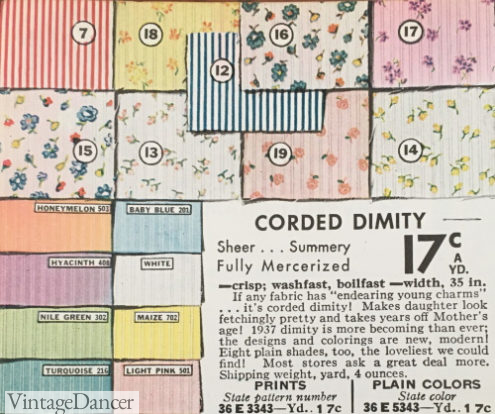
1937 corded dimity in pastels or prints
Seersucker: Was another raised texture pattern. Its weave resembled a waffle texture. It was also light and breathable, popular for summer dress and even men’s suits. Thin stripes and gingham were the most popular patterns.
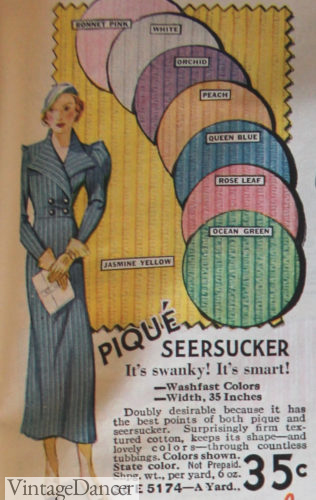
1934 pique seersucker, with striped rows instead of traditional squares
Linen: Linen was one of the best summer suiting fabrics for its breathability. It was a heavier weight compared to most summer cottons, and it could wrinkle very badly, but in hot climates it was a must. Linen was almost always a solid print in a light color, such as this butter yellow with white embroidered flowers.
There were cheaper “linen look” fabrics made of cotton or blends that wrinkled less but had the linen texture. I love the colors of these linen suit fabrics such as turquoise, dusty pinks, maize yellow and rust orange!
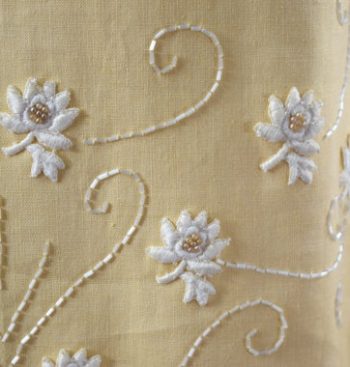
Linen
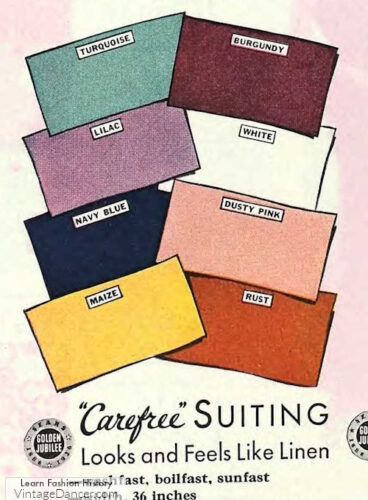
1936 Linen-like suiting fabrics
Crepe: Crepe was the perfect ’30s fabric. It was used more often than any other dress fabric. 1930s crepe was light, flowing and draped nicely, but it was also thick enough to avoid the sheerness issues of cheaper fabrics.
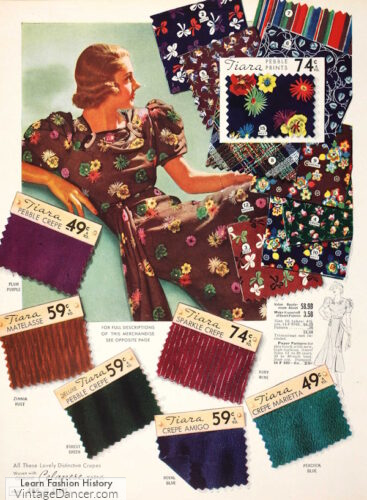
1937 crepe fabrics in many textures
1930s crepe fabric had many subtle textures from smooth (flat crepe), lightly pebbled (small bumps) to twill (vertical lines) and other textures. Crepe could be made of rayon, silk, or cotton, or more likely a blend of two fabrics. Crepe fabric came in solid prints and floral prints in rich saturated colors.
Several of my 1930s catalogs included swatches of crepe.
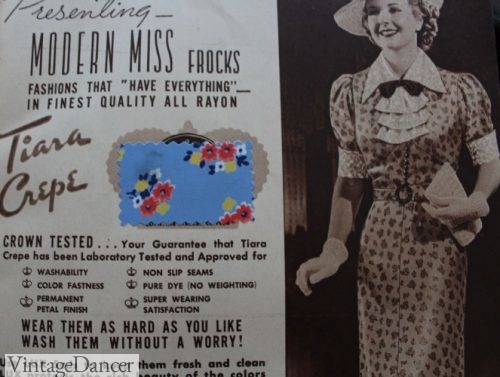
Small floral print blue crepe fabric swatch
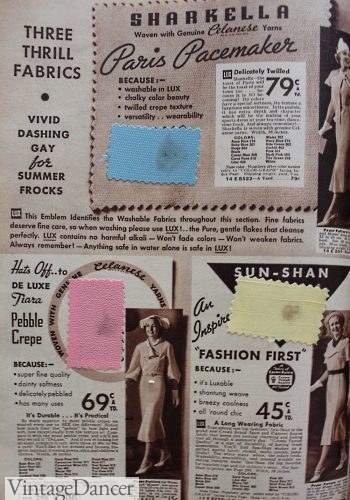
Three textures of crepe
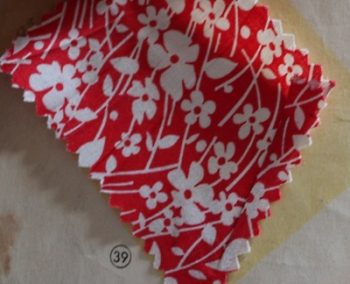
1934 Flat crepe swatch
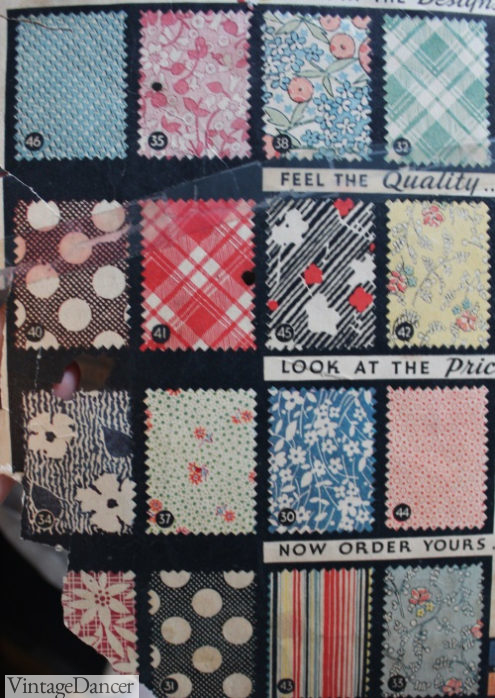
Crepe fabric swatches
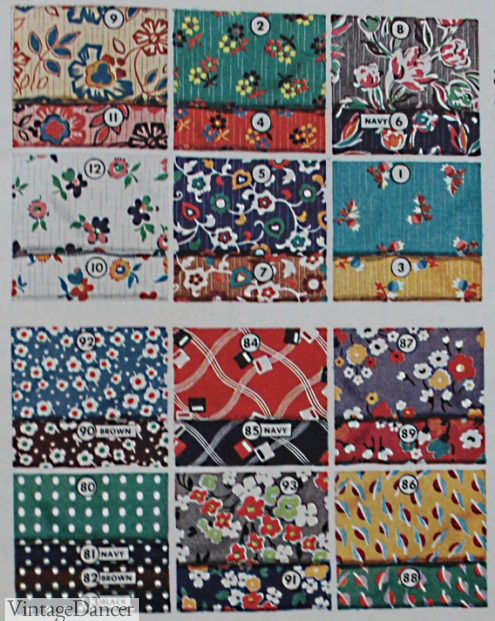
1937 crepe prints- saturated colors
Pongee: Silk pongee, also called tissue silk or Japanese silk, was a lightly textured fine silk most often used in lingerie, pajamas, blouses, Japanese kimonos, robes and springtime dresses. Cotton pongee was also available but not as fine as silk. Solid colors in light pastels and pretty prints made this a dreamy fabric for the boudoir.
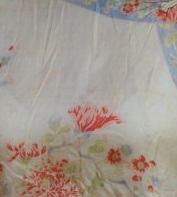
Silk Pongee Print
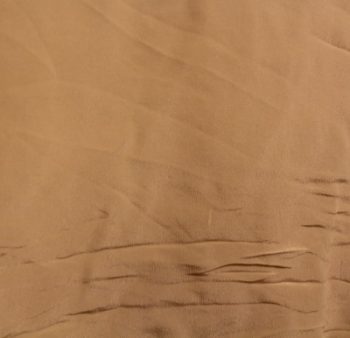
Ivory Silk Pongee
Voile: Light and airy, voile is one of my favorite ’20s/30s fabrics. It breathes in warm weather, drapes nicely, and is surprisingly durable for its delicate feel and semi-sheer weave.
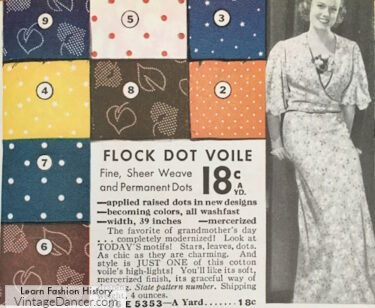
1937 flock dot voile fabrics
1930s voile fabric came in plain colors and some small prints. Being flocked with dots and flowers in white provided some texture to the otherwise smooth fabric. Lawn was a similar fabric made of linen or cotton. What’s the difference?
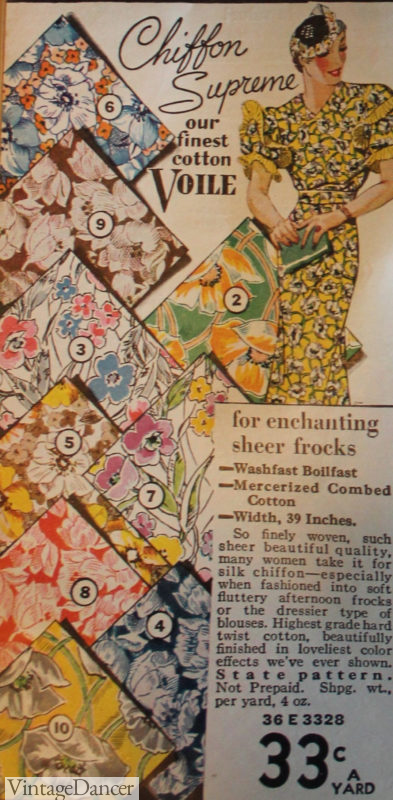
1934 voile floral prints
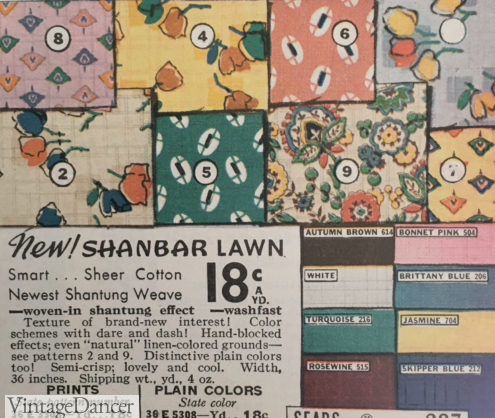
1937 shantung weave lawn, solid and prints
Dotted Swiss was also similar, except the dots were woven instead of printed. It was not always just dots. Small flowers and fruit were also popular. Because of its sheerness, an under layer of cotton backed the Swiss.
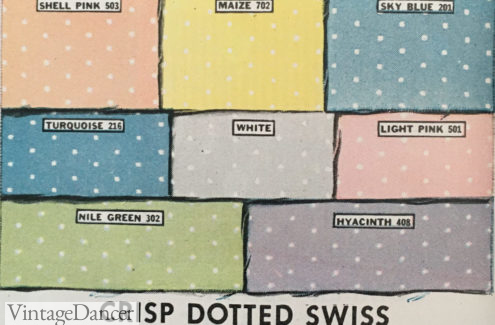
1937 dotted Swiss
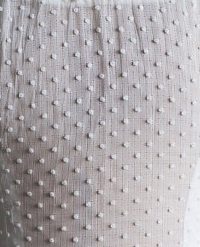
Swiss Dot
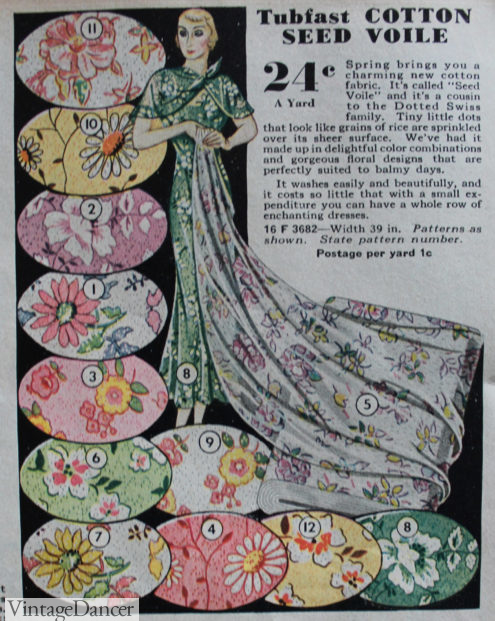
1930 cotton seed voile fabric, similar to swiss with tiny raised dots
1930s Winter Fabrics: Warm and modest textiles
Wool: Wool was the ideal fabric for winter weight clothing, coats, and menswear. Like cotton, it could be turned into a number of different styles of fabrics. It was thick, warm, and often scratchy. It was always a solid color in a flat or textured weave. Wool was often blended with cotton or rayon to make it cheaper, thinner, softer, and shrink resistant.
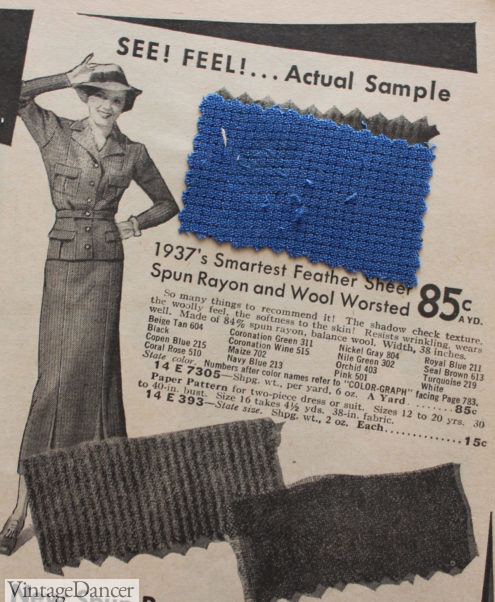
1937 crepe wool blend made into several textures- squares, stripes or smooth
Worsted wool made up most women’s dresses and suits. Flannel wool was also a popular dress, suiting and coat fabric in the 1930s.
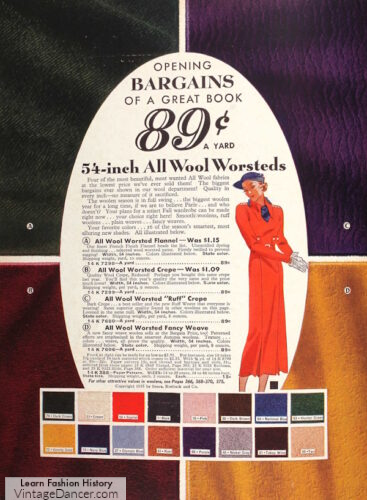
1935 worsted and flannel wool fabrics
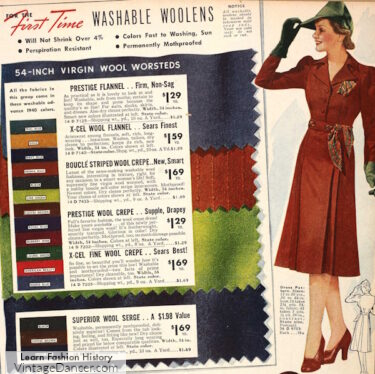
1937 wool fabrics ins several weights of wool flannel and wool crepe
Flannel wool could be made into plaid or tartan prints. Plaid was a popular winter print for dresses, skirts, light jackets, and coats. Flat flannel in solid colors was also used in men’s and women’s suiting.
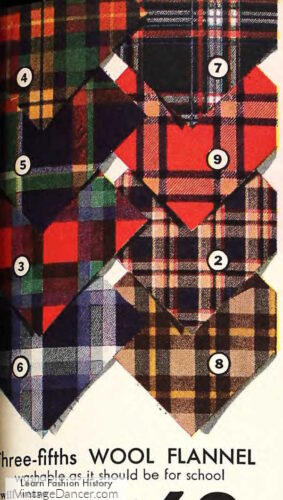
1935 wool flannel plaid fabrics
Chambray: Used prior to the heavy blue denim found in women’s fashion in the early 1940s. Sportswear, workwear, house dresses, uniforms, children’s clothes, and suits used Chambray, a lighter version of denim. It was worn in summer and winter.
Solids, narrow stripes, and wide stripes of multiple colors were all offered. Most colors were light since the weave on white made dark colors speckled and faded instead of solid. Stripes were usually placed vertically.
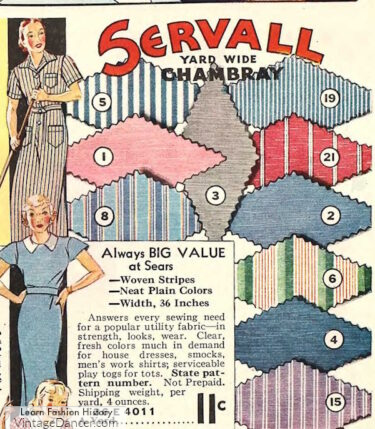
1934 chambray fabrics
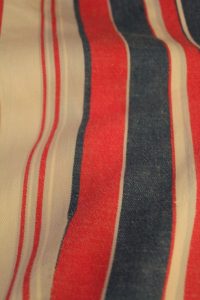
Striped Chambray from a summer playsuit
Corduroy: Corduroy in the 1930s came in narrow grooves of solid colors, although patterns were increasingly popular as well. As a medium-to-heavy fabric, it was used for suiting, winter sportswear, children’s clothing, and accessories like handmade hats and purses.
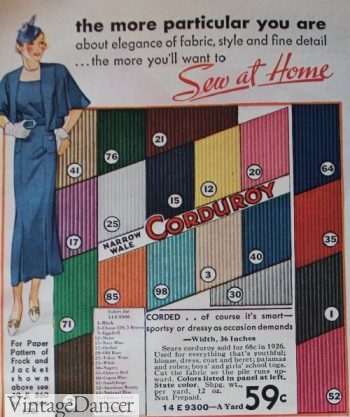
1934 Corduroy
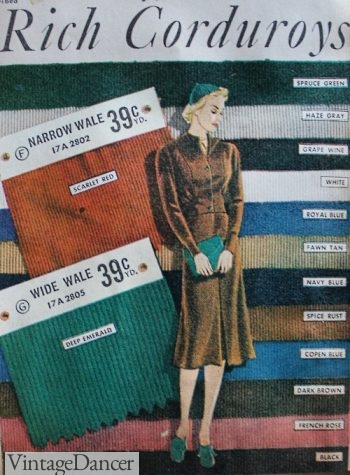
1938 Corduroy
Cotton Flannel: Brushed cotton flannel an excellent fabric for winter sleepwear, young children’s clothes, and blankets. Plaids, checks, stripes, and solids were popular in soft cotton flannel.
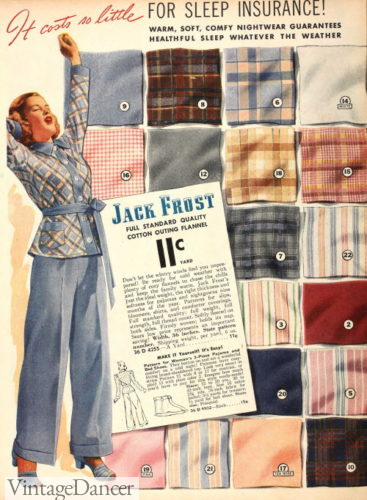
1939 flannel pajama fabrics
Tweed: The tweed weave was an especially popular wool or wool blend winter material used in suiting, outerwear, and sportswear. It was woven into textures such as chevron, checks, dotted “snowflakes,” and waffle squares. It could also be printed on, although the designs were small and muddled in appearance.
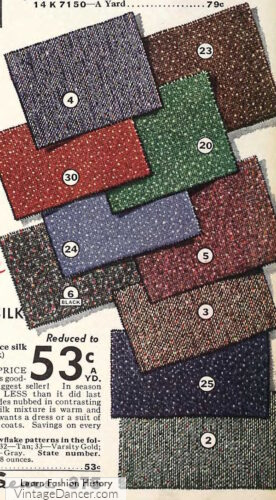
1935 wool tweed
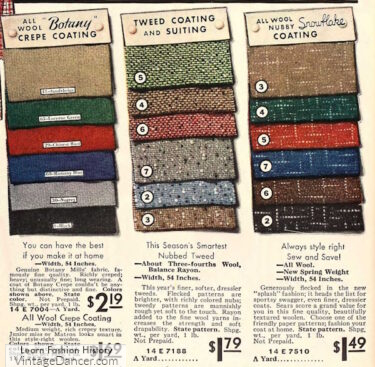
1934 Crepe and wool suiting- smooth, tweed or nubby “snowflake”
1930s Evening Fabrics: A taste of luxury
Frugality was set aside when it came to evening fabrics. Anything shiny was in, including sparkling paste jewelry. Satin reflected light, taffeta glimmered, and even velvet reflected some shine. Evening colors were heavy in gold, peach, emerald green, black, brown, red, and copen blue.
Silk: Although quite expensive, silk was still used in evening dresses and gloves. Blends of silk such as silk-satin or silk-taffeta created a thicker, shinier fabric that the ’30s embraced.
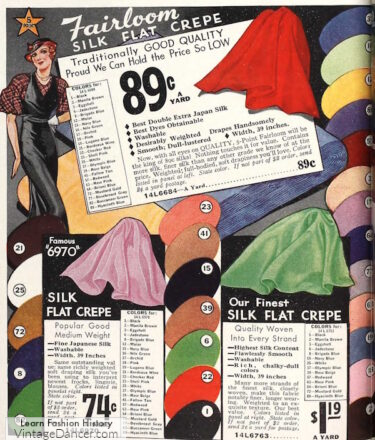
1933 silk for afternoon and evening gowns
Sateen: Satin and sateen were the most popular evening fabrics for bias cut gowns. They draped beautifully, wrinkled little, clung to the body, and were not as delicate as pure silk. Plain color satin was preferred in eveningwear. It was equally popular as a lingerie fabric.
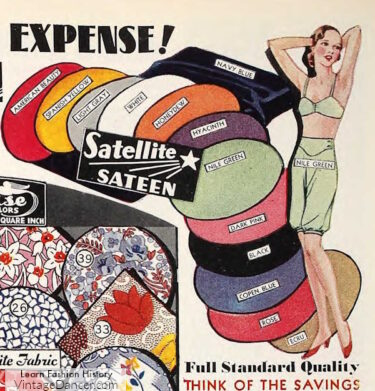
1931 sateen fabric for lingerie
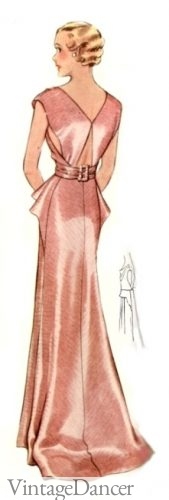
1930s Satin Bias Cut Gown
Taffeta: While I don’t personally like taffeta, it was a good, affordable fabric for evening gowns that needed some body without layering. It was light yet stiff, making it ideal for dress folds and ballgowns. The shine made it shimmer in dim lights. Taffeta could be made from silk, cotton, or rayon with and without shine.
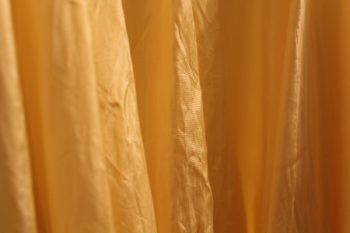
Yellow taffeta from a simple evening gown
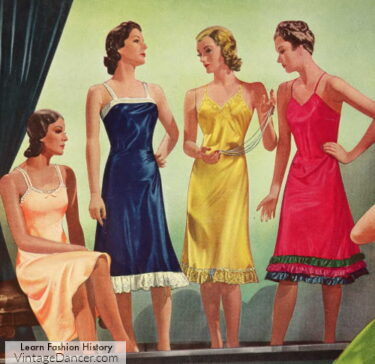
1937 taffeta slips
Most taffeta was a solid bold color but prints were also made up in women’s blouses, children’s clothes, dress trim and lingerie. There was a breif trend for taffeta print afternoon and evening gowns in florals and plaids.
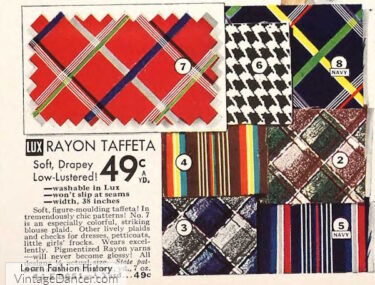
1937 print rayon taffeta for daywear and some evening gowns
Net: For ballgowns and dresses with the most body, a net layered dress (over taffeta) kept a dress light and full. Net was often bedazzled with sequins or ribbon work.
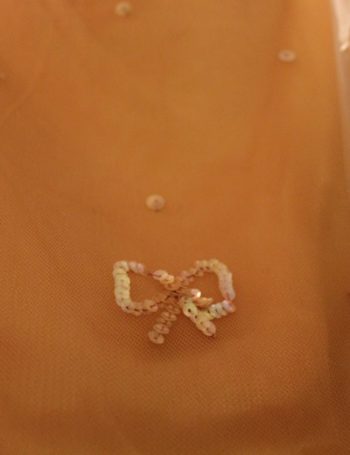
Net over taffeta with sequin ribbon detail
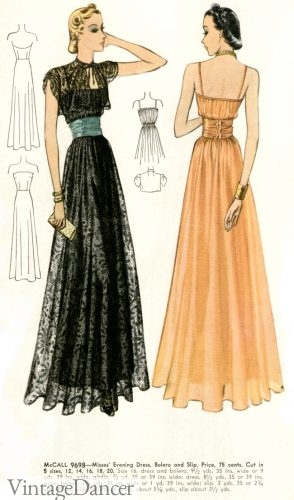
Sheer net evening gowns
Organdie or organdy was on the sheerest fabric but it also had stiffness. It made a wonderful fabric for those iconic puffy sleeves and pleated collar trim. Ballgowns were made of organdy as well as other fancy afternoon dresses for summer.
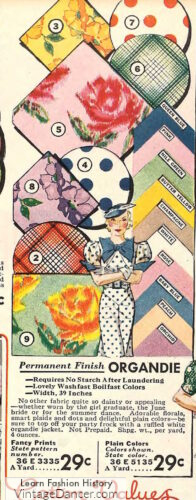
1934 organdie fabrics
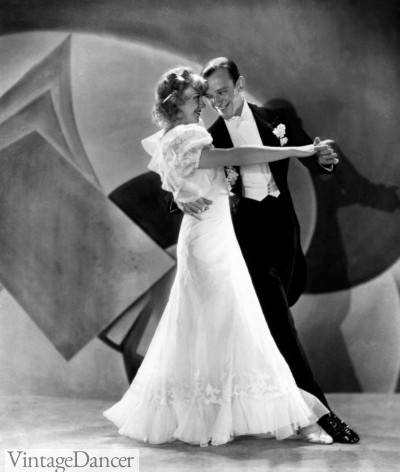
Ginger Rogers and Fred Astaire in Flying Down To Rio, 1933
Velvet: Year-round, but especially in cooler months, velvet was a luxurious evening gown material. It ruched well (see below) and draped with a shine. It was heavier than other fabrics, but buttery soft and oh so divine! Can you tell I LOVE vintage velvet. Modern velvet is heavy, stiff, nasty stuff.
Popular 1930s velvet dress colors were black, royal blue, hunter green, red wine, brown, orange and rich red.
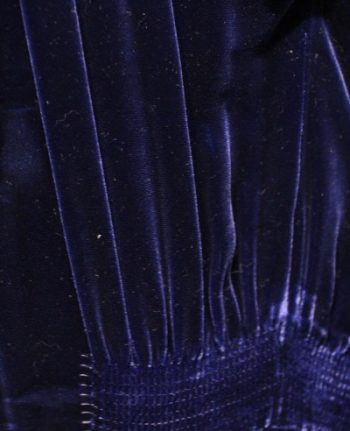
Velvet
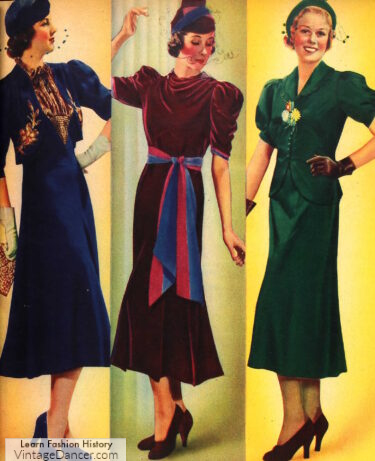
1937 velvet afternoon and cocktail dresses
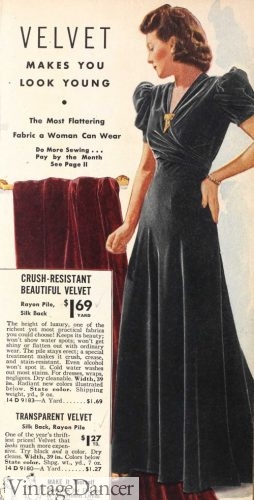
1939 velvet evening gown
Lace – After an almost 10 year hiatus from fashion in the 1920s, lace returned with vigor in the 1930s. Lace was used for collars and dress trims, but if you could afford it, an entire lace gown made a statement of your wealth.
Below, I am wearing a beautiful peach lace evening gown that was worn by a wealthy woman in the 1930s to host elegant house parties.

1930s Peach Lace Evening Dress
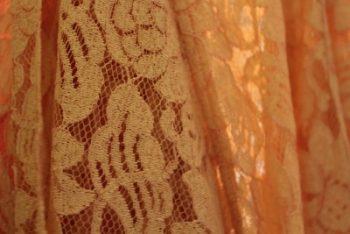
Lace in Peach (VERY popular ’30s color)
1930s Fashion Prints and Patterns
1930s Floral Prints
Prints were a big deal in the 1930s, and not just for house dresses as they had been in the 1920s. Improvements in textile printing meant designs could be printed on almost any kind of fashion fabric available. 1930s prints favored flowers above all else.
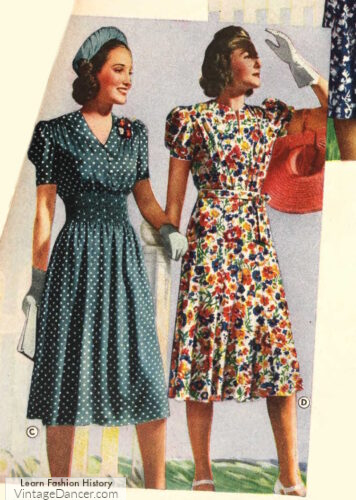
1930s polka dots and bright floral print, 1939
Small floral in simple, painterly designs resembled arts and crafts styles. Florals became slightly larger as the decade aged, but hardly ever grew beyond 3 inch flowers. Although Art Deco was in full swing, there was little Deco design in fashion prints. There were some repeating geometrics, such as diamonds, squares, and of course polka dots.
Slightly larger florals were designed with a tropical flair. Prints of the 1930s remained small and dainty. You can use almost any small printed floral fabric to create 1930s clothing.
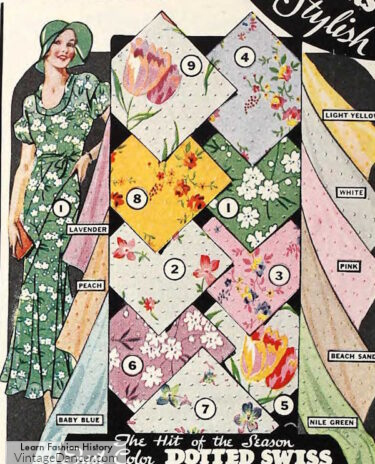
1932 swiss dot florals
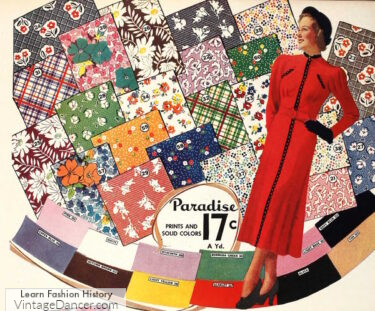
1937 florals
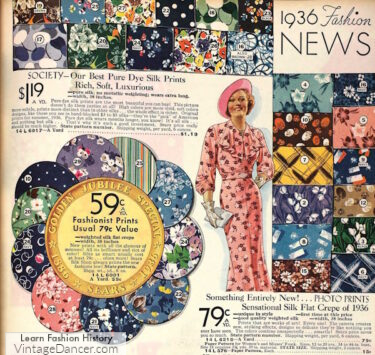
1936 spring floral prints
As the decade moved into the mid century, the floral patterns became more artsy and abstract. Color combinations were bolder, brighter and saturated but still had a lot of white accents.
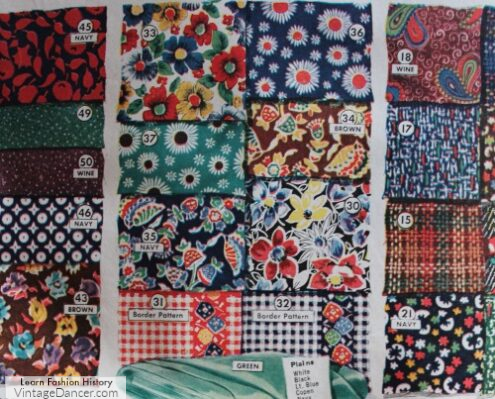
1938 floral and print fabrics in new mid century artistic designs
Polka Dots – Dots never go out of style. The 1930s loved them as much as the 1920s, 1940s, and 1950s did. However, they did not take center stage over florals. Small white dots on a colored background or colored dots on a white background were the choices. Blue, pink, green and yellow were the best polka dot colors. Yellow with brown dots was one of the few examples of dots not being white.
Polka dots were mostly found on accessories, such as scarves and gloves. Many small patterns had the distant look for polka dots but were in fact diamonds, flowers, ovals and medallions.
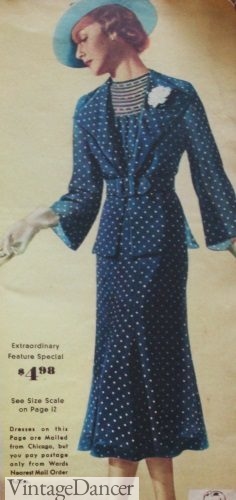
1937 Polka Dot Dress
Plaid – Plaid in the form of Tartan plaid, gingham check, and windowpane never go out of fashion. 1930s plaid patterns were small prints with 3 colors max. Checks and windowpane were simple two-color patterns, with white being one of them. They were mostly used for house dresses and casual frocks and were not especially popular compared to the ’40s and ’50s.
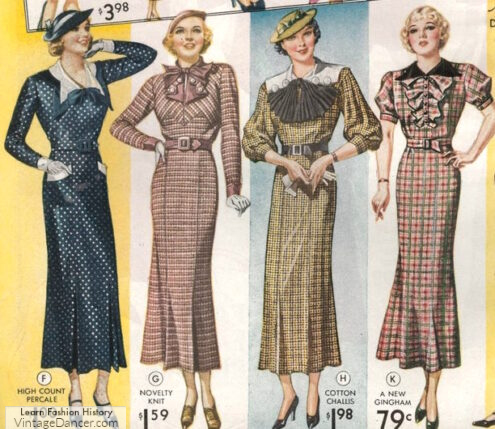
1935 plaid and check dresses
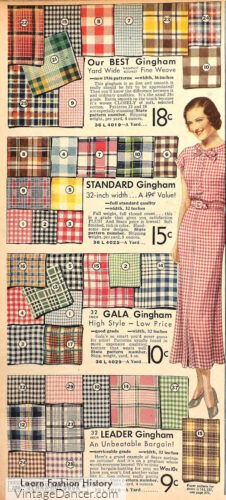
1936 gingham checks
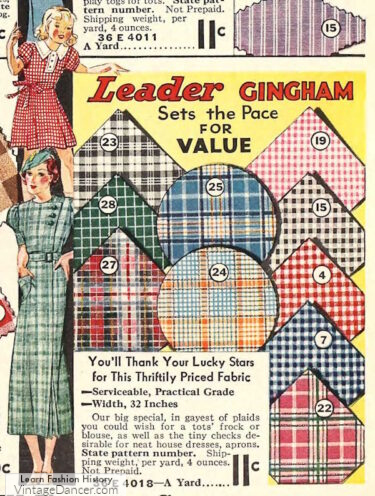
1934 gingham check fabrics
Winter tartan plaids were more popular for suiting, jackets, and skirts.
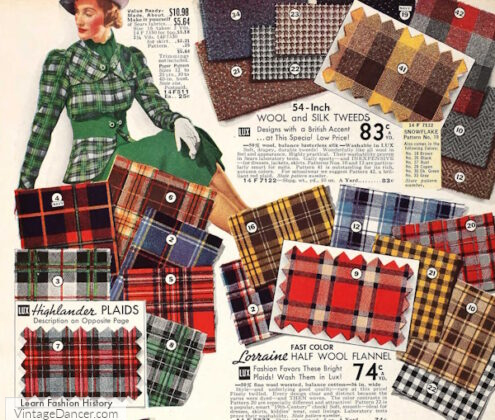
1937 flannel plaid tartan for winter
Paisley– When I think of paisley, I think of ’70s men’s shirts in wild swirls of clashing colors. Little did I realize that the 1930s also loved wild paisley patterns. Large paisley was especially popular with dress suits, afternoon frocks, and some casual blouses. Color combinations had no limits.
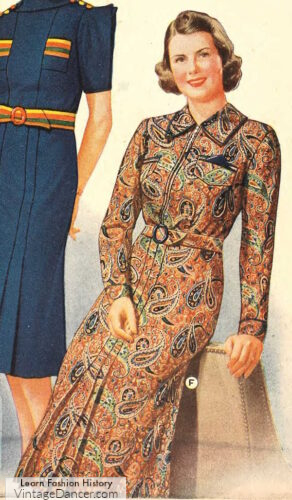
1934 paisley print dress
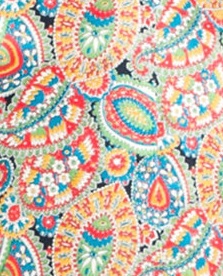
Paisley
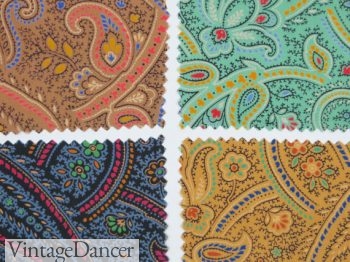
1930s Paisley Fabrics on Etsy
Buying 1930s Fashion Fabrics
You can still find some vintage 1930s on Etsy or eBay, however, the quantity is usually less than one yard. Consider these instead:
- Rick Rack – Original fabrics from the 1930s — mostly cotton prints.
- Antique Fabric – Large collection of original 1930s fabrics.
- Donna Flower (UK) – Charming collection of vintage 1930s fabrics.
- Fabric.com – An assortment of basic fabrics. Sometimes I find great options here.
- Telalinda – 1920s-1940s reproduction fabrics.
- Thai Silks – A huge assortment of silks and silk blends.
- Renaissance Fabrics – Historical fabrics and trims.
- Maltings Fabrics (UK) – Early 20th-century reproduction fabrics.
- Reproduction Fabrics – Mostly heavier cotton/crafting weight fabrics.
- Spoon Flower – Vintage reproduction or inspired designs printed on a variety of fabrics.
- Liberty Fabrics (UK) – Cotton and lawn printed fabrics. Also silk and linen. You can find this brand at most USA quality fabric shops.
- Farm House Fabrics – Cotton, lawn, suiting, silk and more.
- Sew La Di Da (UK) – vintage inspired cotton, linen, crepe, etc.
- Til The Sun Goes Down (UK) – Vintage inspired designs from the 20s-60s.
- B Back and Sons – Wool, cashmere and silk. Wool suiting ideal for menswear
- Dharma Trading – Dyeable silk, cotton, rayon and linen fabrics
- Burley and Trowbridge– Cotton, wool, silk and linen historical fabrics
- NY Fashion Center – Fashion fabrics, all kinds
- Mood Fabrics – Designer fashion fabrics, all kinds. Trims and leather too
- Fashion Fabrics Club – More fashion fabrics
- Fabric Mart Fabrics – Organized by fabric type
- IKEA – some amazing historical clothing has been made from Ikea’s fabric and curtains
- Farthingale – Corset, garter, bra making supplies and some fabric
1930s notions for sale:
- http://www.thebuttonbower.com/ – Buttons, buttons, buttons!
- http://www.accessoriesofold.com/ – Beads, buttons, trim, and more
- http://www.vintagebuttons.net/ – Buttons, jewelry and more
- 1935 buttons and buckles
- 1936 buttons and buckles
- 1934 crochet lace trim
- 1934 lace trim
Shop–> 1930s Sewing Patterns
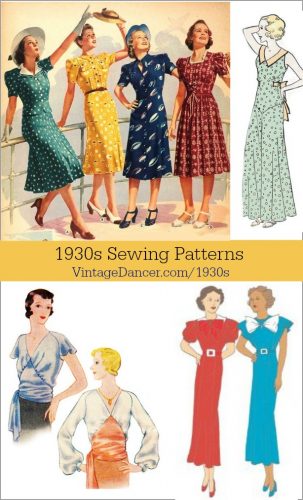
Shop 1930s sewing patterns you will love. Dresses, tops, skirts, coats, pants, lingerie, beach pajamas and more. VintageDancer.com/1930s
More Color and Fabric History
- 1920s Fabrics and Colors in Fashion
- 1940s Fabrics and Colors in Fashion
- 1950s Fabrics and Colors in Fashion
- 1960s Fabrics and Colors in Fashion
Debbie Sessions has been teaching fashion history and helping people dress for vintage themed events since 2009. She has turned a hobby into VintageDancer.com with hundreds of well researched articles and hand picked links to vintage inspired clothing online. She aims to make dressing accurately (or not) an affordable option for all. Oh, and she dances too.
